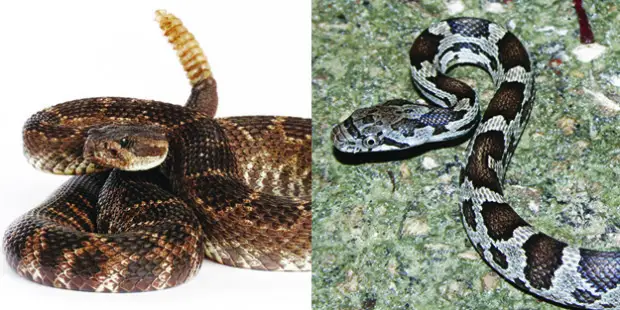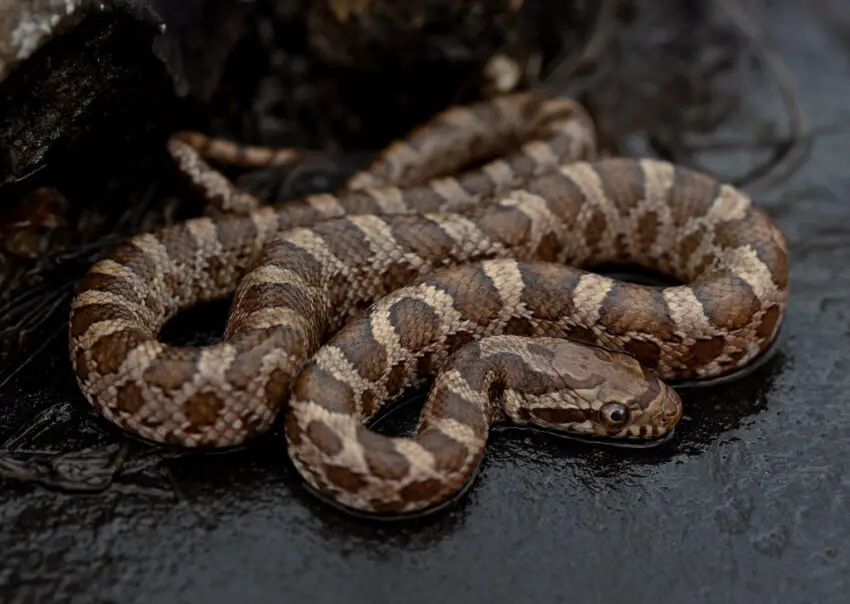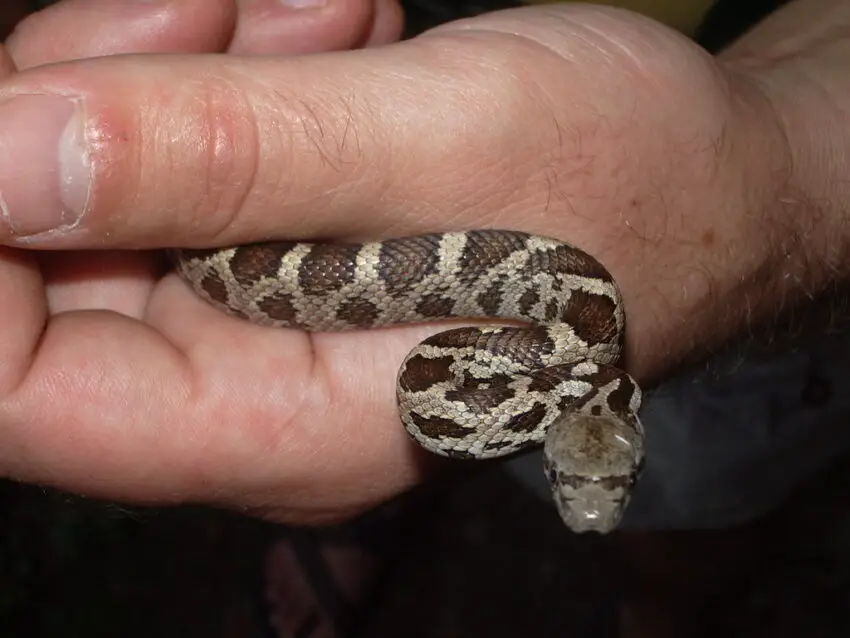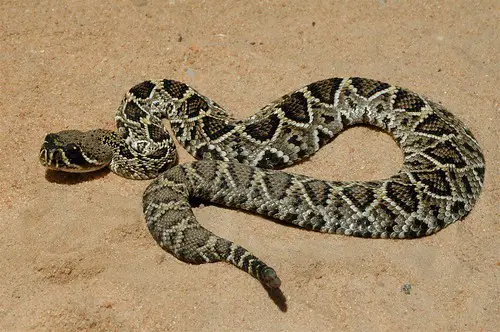Side-by-Side Comparison: Rattlesnake vs. Rat Snake
Table of Contents
Rat snakes and rattlesnakes are both species of snakes, but they differ significantly in terms of physical characteristics and behavior. Rat snakes are non-venomous and are native to various parts of North America, Europe, and Asia. They are slender, with smooth scales and a pointed head. Their coloration can vary, but they are typically brown or gray with black or brown patterns. Rat snakes are commonly found in wooded areas, farmland, and suburban gardens where they prey on rodents, birds, and other small animals.

On the other hand, rattlesnakes are venomous snakes that are found in America, from Canada to Argentina. They are easily identifiable by the rattle at the end of their tail which they use as a warning sign to predators. Rattlesnakes have triangular-shaped heads, and their bodies are covered in scales that have a rough texture. Their coloration can vary, but they are typically brown or gray with black or brown blotches. Rattlesnakes are commonly found in rocky, desert terrain where they prey on small mammals, birds, and lizards.
It is important to know the differences between these two species, especially if you are an outdoor enthusiast or live in an area where these snakes are commonly found. Understanding the physical characteristics and behaviors of each species can help you avoid potential encounters and ensure your own safety.
Physical appearance and distinguishing features
When it comes to physical appearance, rat snakes and rattlesnakes look quite different from each other. Rat snakes have slender bodies, narrow heads, and smooth scales. They come in a variety of colors such as green, brown, black, and grey. Some species of rat snakes even have patterns on their body, making them easy to identify. However, one thing to note is that some species of rat snakes can look similar to rattlesnakes, so it’s important to be able to distinguish between the two.
On the other hand, rattlesnakes have thicker bodies, triangular-shaped heads, and rough, keeled scales. They have a distinct rattle at the end of their tail, which makes them easy to identify. The rattle is made up of layers of keratin, the same material that makes up human hair and nails. With each shedding of skin, a new layer is added to the rattle, making it longer and louder. Rattlesnakes also have a heat-sensing organ located between their eyes and nostrils, which allows them to detect prey and predators in the dark.
Habitat and geographic range
When it comes to the habitat and geographic range of rat snakes and rattlesnakes, there are some notable differences between the two species.
Rat snakes are found in a wide range of habitats, including forests, fields, marshes, and even urban areas. They are native to North America and can be found throughout the United States, as well as in parts of Mexico and Canada. These snakes are non-venomous and are known for being excellent climbers, often found in trees or on fence posts.
On the other hand, rattlesnakes have a more limited range and are typically found in arid or semi-arid environments, such as deserts, grasslands, and rocky areas. They are native to the Americas, with species ranging from Canada all the way down to Argentina. Rattlesnakes are venomous and are known for their distinctive rattle, which they use as a warning to potential predators.
It’s worth noting that there are some species of rat snakes, such as the gray rat snake and yellow rat snake, that can be confused with rattlesnakes due to their similar coloration and pattern. However, if you know what to look for, it’s usually fairly easy to distinguish between the two species based on their physical characteristics and behavior.
Diet and feeding habits
When it comes to diet and feeding habits, rat snakes and rattlesnakes have a few differences. Rat snakes are non-venomous and primarily feed on rodents, birds, and eggs. They are great climbers and can easily catch prey in trees and bushes. Rattlesnakes, on the other hand, are venomous and primarily feed on small mammals such as mice, rats, and rabbits. They have a unique method of hunting where they wait for their prey to come close and strike them with their venomous fangs.
Another difference between the two is that rat snakes are known to eat other snakes, including venomous ones. They are immune to the venom of most snake species and can easily overpower and eat them. Rattlesnakes, on the other hand, do not normally eat other snakes, although they may occasionally consume smaller individuals of their own species.
It’s important to note that both rat snakes and rattlesnakes play important roles in their respective ecosystems. Rat snakes help control rodent populations, while rattlesnakes help control small mammal populations. It’s important to understand the differences between the two to better appreciate and respect their unique roles in nature.
Venomous or non-venomous: a critical difference
One of the most critical differences between a Rat Snake and a Rattlesnake is whether or not they are venomous. Rat Snakes are non-venomous, while Rattlesnakes are venomous. This means that if you encounter a Rattlesnake and it bites you, the venom can be life-threatening. Rat Snakes, on the other hand, do not pose this danger.

It’s important to note that not all snakes are venomous, but it’s important to be able to tell the difference between venomous and non-venomous snakes. Venomous snakes have triangular-shaped heads, slit-like eyes, and a pit between their eyes and nostrils. Non-venomous snakes have a more rounded head and round pupils.
In the case of Rat Snakes and Rattlesnakes, the difference is obvious. Rat Snakes have a slim body with a pointed head, while Rattlesnakes have a broader, diamond-shaped head. Additionally, Rattlesnakes have a rattle on their tail, which they use to warn potential threats.
Reproduction and breeding behavior
The reproduction and breeding behavior of rat snakes and rattlesnakes are quite different. Rat snakes are known to be oviparous, which means they lay eggs. These eggs are laid in a warm and safe place, and the female rat snake usually stays near the eggs until they hatch. Once the eggs hatch, the young rat snakes are left to fend for themselves.
On the other hand, rattlesnakes are ovoviviparous, which means their eggs develop and hatch inside the female’s body. The young rattlesnakes are then born live. Rattlesnakes do not stay with their young after birth, as they are born with the ability to fend for themselves.
In terms of breeding behavior, male rat snakes are known to compete with each other for mating rights with females. They often engage in combat, where they entwine their bodies and try to push each other away. The winner of the combat earns the right to mate with the female.
Rattlesnakes, on the other hand, do not engage in combat for mating rights. Instead, the male rattlesnake will follow the female until she is ready to mate. The male will then perform a courtship ritual, where he will rub his chin on the female’s head and body.
Threats and predators of Rat Snakes vs. Rattlesnakes
Both Rat Snakes and Rattlesnakes have their fair share of predators and threats. Rat Snakes, their main threats are humans, who often mistake them for venomous snakes and kill them on sight. They are also preyed upon by larger animals such as hawks, eagles, and other birds of prey, as well as raccoons, foxes, and other small predators.

On the other hand, Rattlesnakes have a distinct advantage over Rat Snakes – their venomous bite. Though they use their rattle as a warning signal to potential predators, they are still preyed upon by larger animals such as coyotes, bobcats, and other snakes. However, their venomous bite is their greatest defense mechanism against predators.
When it comes to threats to humans, Rattlesnakes pose a much greater danger than Rat Snakes. Rattlesnakes can be found in many parts of the world, and their venomous bite can cause serious injury or even death if not treated promptly. Rat Snakes, on the other hand, are non-venomous and pose no threat to humans.
How to identify a Rat Snake or a Rattlesnake
Being able to identify a snake is essential, especially if you live in an area that is home to both rat snakes and rattlesnakes. Rat snakes and rattlesnakes may look similar at first glance, but there are a few key differences that can help you tell them apart.

Rat snakes are typically thin with long, slender bodies. They have round pupils and a shiny appearance to their scales. They can vary in color but are generally gray or brown with darker markings down their back. Rat snakes are non-venomous and are not a threat to humans.

Rattlesnakes, on the other hand, have a distinctive rattle at the end of their tail, which can alert humans to their presence. They have triangular-shaped heads and vertical pupils. Their scales are also more dull in appearance and they have a distinct color pattern of alternating light and dark bands. Rattlesnakes are venomous and can be dangerous to humans.
If you come across a snake and are unsure of its species, it’s best to keep your distance and call a professional for assistance. Remember, it’s always better to err on the side of caution when it comes to potentially dangerous wildlife.
How to stay safe around Rat Snakes and Rattlesnakes
When it comes to snakes, safety should always be your top priority. Though both rat snakes and rattlesnakes can be found in similar geographic regions, they vary greatly in their behavior and potential danger to humans.
Firstly, it’s important to remember that all snakes are potentially dangerous and should be treated with respect. However, rat snakes are generally not venomous and are not known to pose a significant threat to humans. They are often found in residential areas and can be beneficial in controlling rodent populations.
Rattlesnakes, on the other hand, are venomous and can be extremely dangerous. They are often identified by their distinctive rattle, which they use as a warning signal when they feel threatened. If you encounter a rattlesnake, it’s important to give it plenty of space and avoid startling it.
To stay safe around both rat snakes and rattlesnakes, it’s important to be aware of your surroundings. If you are hiking or exploring in areas where these snakes are known to live, wear sturdy shoes and watch your step. Avoid reaching into areas where snakes may be hiding and keep your pets on a leash to prevent them from accidentally encountering a snake.
In the event that you are bitten by a snake, seek medical attention immediately. Try to identify the type of snake if possible, but do not attempt to capture or kill it.
Conclusion and final thoughts.
When it comes to deciding whether a Rat Snake or a Rattlesnake is better, the answer is not that straightforward. It all depends on what you are looking for and what your priorities are.
If you are looking for a pet snake, then a Rat Snake could be a better option for you. They are generally easier to care for and are less venomous compared to Rattlesnakes. On the other hand, if you are looking for a snake for pest control, a Rat Snake might not be effective as they are not known to eat rodents as much as Rattlesnakes are.
If you are looking for a snake to keep as a pet and want a more docile and friendly snake, a Rat Snake could be a better option. They are usually more tolerant of handling and are less likely to bite or show aggression compared to Rattlesnakes.
However, if you are looking for a snake that is more unique and has more of a “wow factor”, then a Rattlesnake might be the better option. They are known for their distinctive rattling sound and their venomous bites make them a more intriguing choice for some people.
Ultimately, the decision between a Rat Snake and a Rattlesnake comes down to personal preference and what you are looking for in a snake. Both snakes have their own unique characteristics and can make great pets or pest control options depending on your needs.
We hope you enjoyed reading our comparison between rat snakes and rattlesnakes. Both of these snakes are fascinating creatures with unique characteristics. We have provided you with a detailed overview of their differences in appearance, behavior, and habitat. By understanding these differences, you can better identify which snake you are dealing with and how to react in case of an encounter. Remember to always be cautious around snakes and respect their space. Thank you for reading, and we hope you learned something new today!
